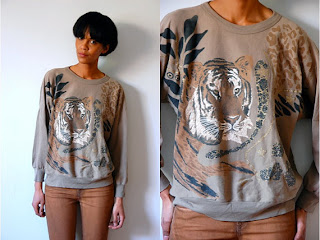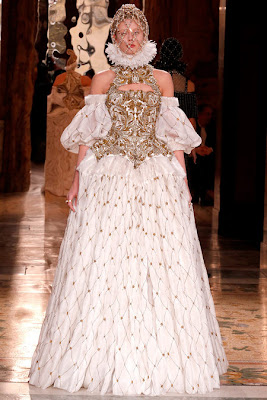 |
| In my defense, this dress is kind of mesmerizing. Just look at all the STUFF!! |
This post is late because:
1. I was obsessing over a different project
2. I was reluctant to stop talking about Queen Elizabeth since I think she's super cool, and
3. I couldn't figure out why fashion in this era had changed so much and what it meant.
So, really, I don't have an excuse at all. But, with all the thinking and obsessing I did, I realized that I haven't covered some abstract ideas which might be very helpful in thinking about fashion, history, and the people who make all of it. That is what we will be discussing today. Since it's a late post, there will be a test but there won't be any assignments so just read and think and we will get back to the work next week.
I want to discuss is what exactly fashion/clothing IS. I mean, yes, it's things you put on your body, but why does it look like anything other than this?
 |
| "Flexable, comfortable, adaptable, and it matches my hair! Perfect!" |
Or, if you need sleeves, this:
 |
| I'm pretty sure this photo is sillier than the other one. I also think this man might have done steriods at some point in his life. |
Well, there is a duality to clothing which combines to make a very interesting visual language. First of all, clothing is something people MAKE. And humans, when they make stuff, tend to express themselves in the act of creation. That's what art is, basically. Creation which communicates.
 |
| No, really, that's what art is. I promise. Painting by James W. Johnson |
 |
| That answer to that question apparently is "no". |
Any of that stuff look familiar? This is from the Fall 2013 Ready To Wear Collection by Alexander McQueen. I know you can't see it very closely, but all the white designs on the black dresses are made by individually stitched pearls. There is an INSANE amound of detail and work put into making dresses which look a lot like Elizabeth I.
Now, obviously you aren't going to pick up some milk at Smiths wearing a dress like this. Head baskets will not be the new fashion trend of the fall. Ruffs won't make a sudden and surprising burst into everyone's daily beauty routine. Viewing these garments as just stuff to wear means you are missing the art of them, and the beauty. To really appreciate them one should just look at them like you would a painting, or a movie. Just listen to what your internal response to them is. Think about how the shapes remind you of other stuff. Look at how the different lines and curves are composed. Notice what historical or social ideas you bring with you when seeing the clothing. See if you can tell what the values of the object are, and if they bump against or meet up with yours. Then, when you've done all that, just look at it again 'cause this stuff is PRETTY!
 |
| All that Battenburg lace is made by hand. |
 |
| ALL of it |

 |
| And every single pearl is stiched onto leather by hand |
So, that's your art apprciation for the day. Make sure you take a minute and really look because I will ask you questions about this on your quiz.
I said fashion is dualistic in nature. If the first part is individual expression, the second part is social signaling. Social signaling is the part of fashion we normally think of first. It's the reason we have shows like "What Not To Wear", feel comfortable criticizing other people's fashion choices, and worry about what other people will think of us when we get dressed. (Well, some people worry. You may not.)
 |
| "I, too, am not worried about what others think because if they do think, they know I am AWESOME!" |
So, sometimes people wear clothing to get attention.
 |
| "This is what Google Glasses SHOULD have looked like" |
 |
| "I paid a lot for this blanket so make sure you see that it's a Louis Vitton!" |
 |
| "We make poor choices" |
 |
| I see London, I see France.. |
 |
| "This is my "tough guy" disguise. Is it working??" |
 |
| You know, like this. |
 |
| "what?" |
Showing off and getting attention is a valid use of clothing. Everyone needs attention and social approval. Clothing is a way to get that. Also, sometimes, it can get you a boyfriend/girlfriend. Or so I've been told.
Clothing also displays status. By choosing what we wear we show how important we think we are or how much money we have. This guy looks rich.
This guy does not.
Both of the above outfits are from designers and both are expensive. The shape of the clothing we associate with status and power is stronger, culturally, for the guy in the sport jacket than for the dude in the headband, so the actual material used or cost doesn't hit us unless we look closely. Well, and the painty hands might also affect your judgement a bit...
But, we already knew that clothing communicates status and wealth. There wouldn't have been sumptuary laws invented in the past if folks in power didn't want to be visably different from those persons poorer or "lower" than them.
What about people who aren't giant peacocks? What about people who just wear clothing they like, are comfortable in, or think looks nice?
All of that seems like a lot but we do it without thinking. It's kind of like breathing. It's only complex if we stop to think about it.
I think this is a good place to stop. Remind me to discuss sillouette and waistlines later. But, for now,
your test!
https://docs.google.com/forms/d/1fNmK23yvxKw3rOnW5PRQGFgTWuLcTREI6-C97Vf4clM/viewform
















No comments:
Post a Comment